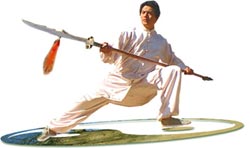|
|
|

The Chinese were the first to catalog and develop the fighting arts to a higher level beyond the mere fighting
strategies. Kung Fu became a mental discipline and a vehicle for enlightenment. The Chinese monks that
developed Kung Fu believed that the mind was supreme and by constant practice of forms their bodies and minds
would work together harmoniously to defeat any attacker.
Many styles of Kung Fu revolved around the ideas of metaphysics and nature. Ancient Kung Fu masters often
developed their fighting techniques by observing the world around them. Animals, birds, and insects provided
the basis for many systems of Kung Fu developed in the past. Other influential factors were the beliefs of
Chinese philosophy and religion.
Most of the internal styles of Kung Fu such as Tai Chi Chuan are rooted in the teaching of Taoism. Through
it’s training, one can attain inner peace and a sense of physical and emotional well being. In addition to its value
as a means of self-defense, internal styles of Kung Fu are highly beneficial for the promotion of good health.
Many of the external styles of Kung Fu can be traced their origin to the Shaolin Monastery. It was there that a
mysterious Indian priest named Tamo, also known as Budhidharma, established residence nearly 1500 years
ago. According to legend, Tamo introduced a series of exercises to the monks designed to nourish both their
bodies and minds due to their poor health. These movements are said to have merged with self-defense tactics
studied in Shaolin Temple.
Although many details of the Shaolin art are not clear, records indicate that monks from the Temple proved
themselves formidable fighters in many historical battles. Down through the centuries, the Shaolin art became
renowned for the skill of its boxing monks. Behind the Temple walls, self-discipline augmented technical skill. A
rigid code of ethics was established to improve the caliber of Shaolin boxer. In the addition to the development
of fighting skill, humility, prudence, patience, and dedication became equally important in the Shaolin way of life.
For centuries, the secrets of Shaolin Kung Fu remained hidden within the Temple. When the Manchus conquered
China in the 17th Century, officials and supporters of the defeated Ming dynasty sought refuge at the Shaolin
Monastery. Fearful of a possible uprising, the Manchu government launched several attacks on the Temple.
During the final attack, legend says that the Shaolin Monastery was burned to the ground. Monks and boxers
who survived this raid, however, established new lives in the outside world, and in so doing, propagated the
Shaolin art throughout the four corners of China.
